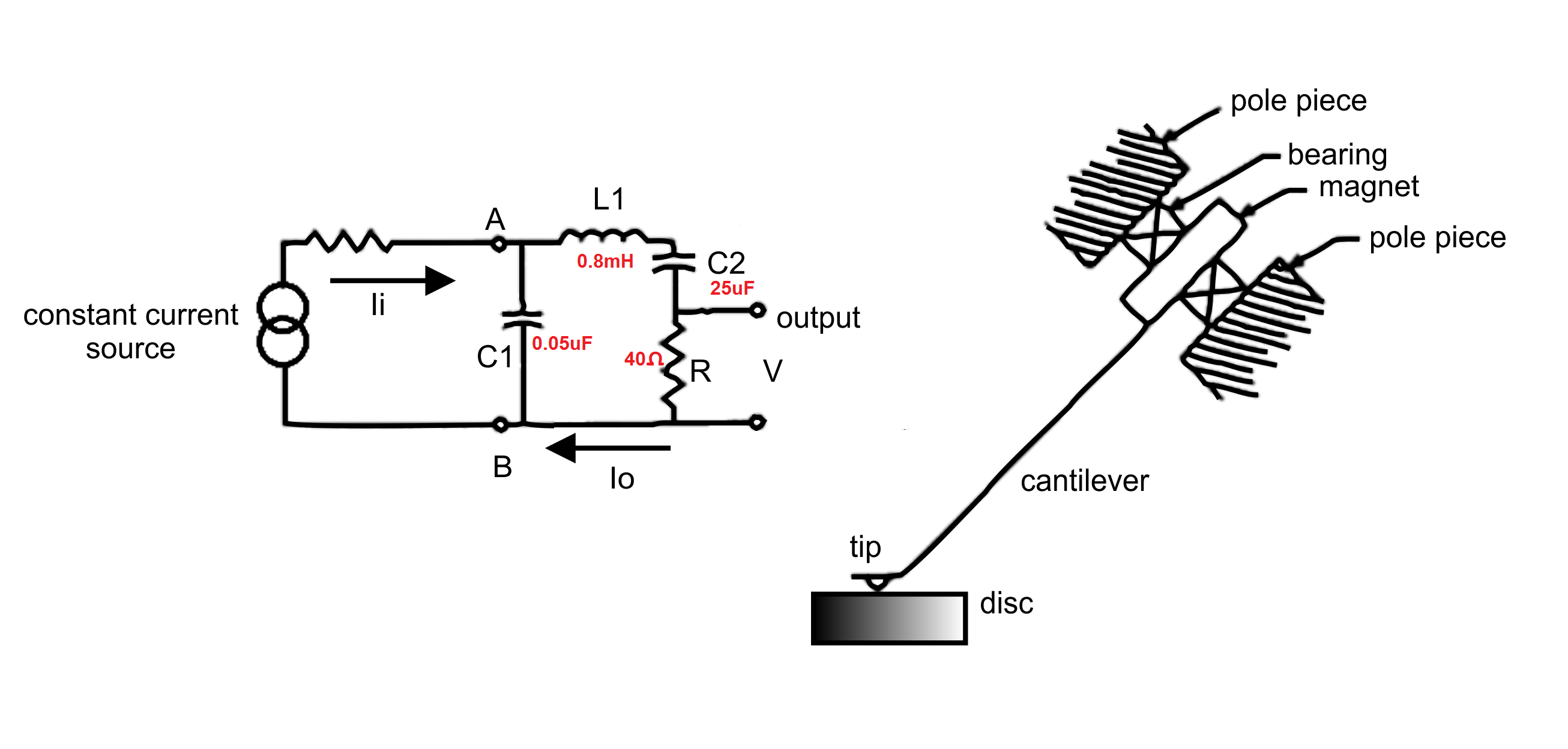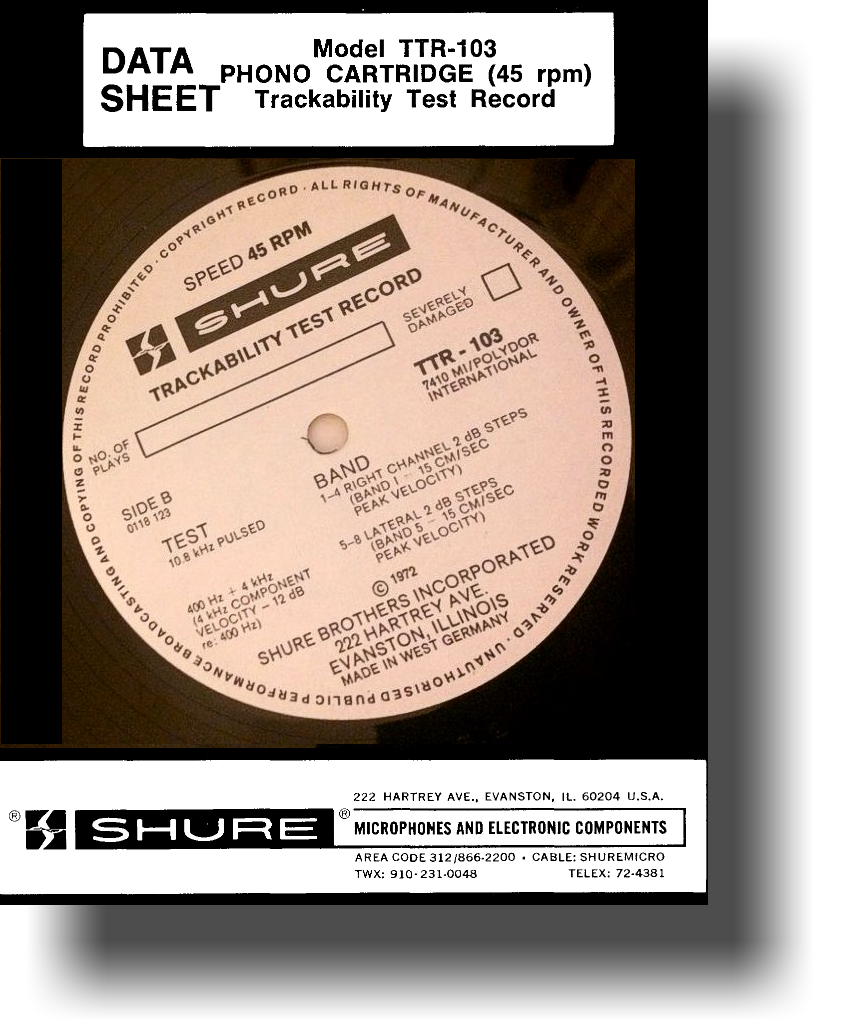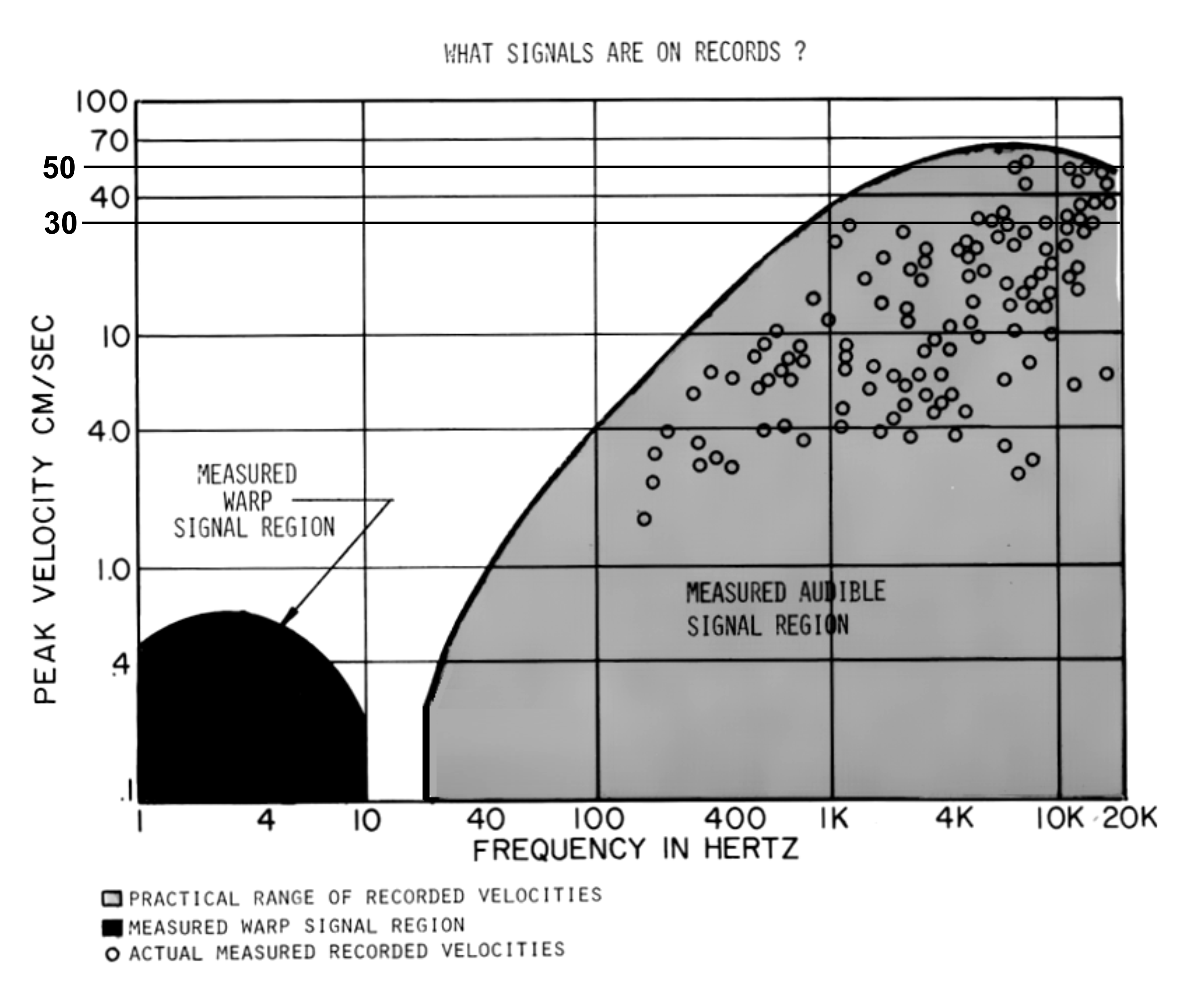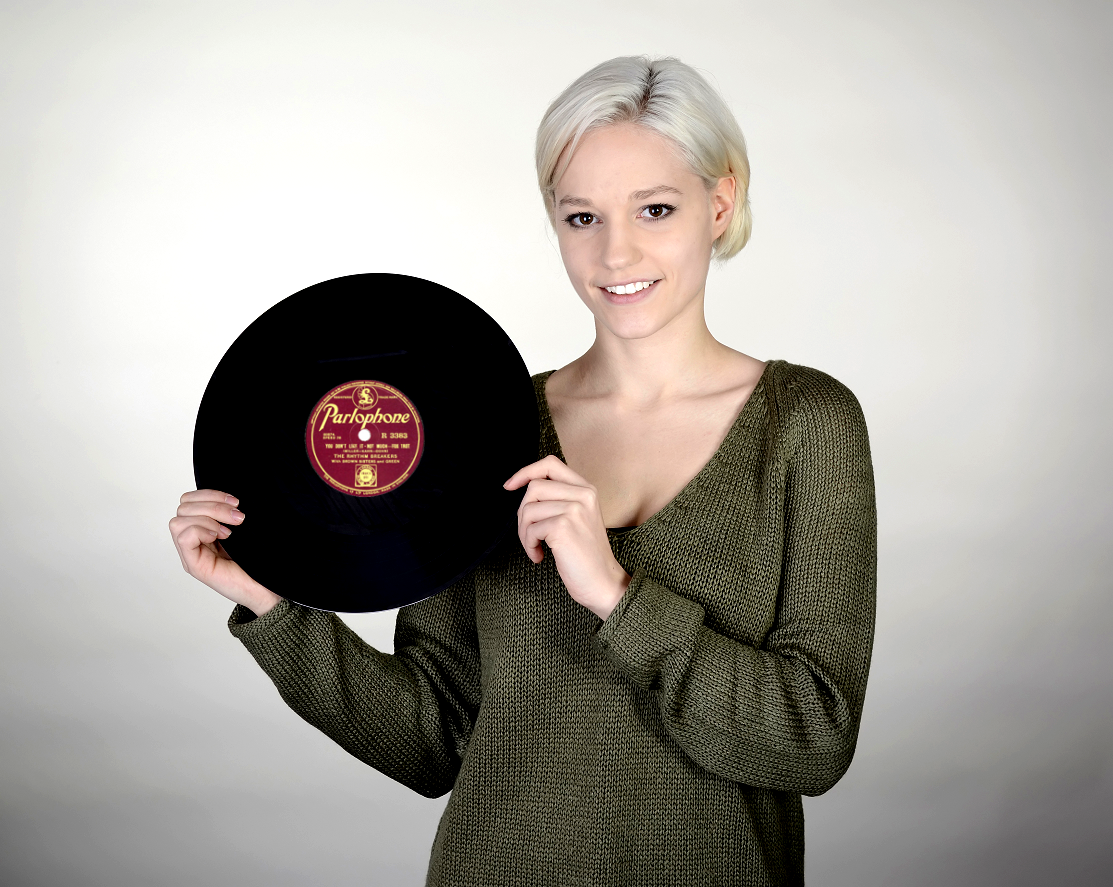
❝ Perfect tracking is a necessary, but not a sufficient, criterion of the adequacy of a pickup, whereas imperfect tracking, ... is a certain guarantee of inadequacy.❞
The micro-photographs (from Shure, below)³ shows an example of what happens to the groove when the signal is not tracked properly. The photo on the left shows the condition of the groove after being played 50 times with a stylus that tracked the signal. The other photo shows the same portion of an identical record played with a stylus that mistracked one time.
As Shure's Karlov says, ❝ One may say that the primary function of a phono pickup is to "dig out" the information from the groove. Here we see that, indeed, there has been some digging, but the information has not been retrieved nor can it ever be from this abused groove.❞ ³
The crucial point here is that good tracking ability of a phono cartridge underwrites all other aspect of its performance. All bets are off once the stylus has parted company with the groove.
Seeing "trackability" in terms of (possibly permanent) information loss raises what seems to be a rather esoteric issue to centre-stage — certainly for the record collector and archivist. So, on this page we embark upon a more serious and fundamental study of measuring the tracking performance of phono cartridges.
 It was the physicist Ludwig Boltzmann who said, "There is nothing so practical as a really good theory" and the work of Hunt at Harvard University and the development team at Shure Brothers, Inc. of Evanston, Illinois furnished us with a "really good theory" for the dynamical physical system of a phonograph cartridge.
It was the physicist Ludwig Boltzmann who said, "There is nothing so practical as a really good theory" and the work of Hunt at Harvard University and the development team at Shure Brothers, Inc. of Evanston, Illinois furnished us with a "really good theory" for the dynamical physical system of a phonograph cartridge.
The nub of the issue in the design of phono cartridges for good "trackability" is that there exist conflicting requirements in achieving good tracking simultaneously in the low, mid, and high frequency regions.
The visualisation of the mechanism of the cartridge and its interactions with the disc is greatly aided, if you have an electrical engineering background, by an equivalent circuit analogy which is illustrated (right).
The industry-standard test for tracking ability consists of taking the cartridge through a series of Labours of Hercules in the form of 300Hz test tracks of increasing displacement.
The initial band in this test is usually about +6dB relative to standard 0dB recording level which is equivalent to a displacement of 11.2µm peak at 300Hz.
Any cartridge with a pretention to quality will track the first few bands of this test sequence up to a level which is +12dB relative to standard recording level; a modulation of 90µm peak-to-peak (usually referred to as 45µm peak = 8.5cm/s). Indeed, this is the band on which harmonic distortion tests are usually performed.
The bands of 300Hz modulation then increase through various torture levels6 to a final modulation of +18dB relative to reference level; a physical peak-to-peak modulation of 180µm (90µm modulation peak = 17cm/s).
Testing for tracking involves the simple process of lowering the stylus on these bands of increasing modulation and listening for the point that the stylus rattles in the groove or mistracks. This is betrayed by a change in the tone so that - to the pure note somewhere between D and D# above middle C - a rasping, octave buzz is added. (Ideally, listening is augmented by looking at the waveform on a display: an osilloscope or the waveform display in a DAW.)
The cartridge's ability to track is defined by the peak modulation of the last band in which the stylus negotiates the groove without mistracking. Thus we see a tracking specification such as: Tracking ability (300Hz): 80µm lateral.
❝ The 300Hz tracking tests are useful as part of a bigger picture, but in isolation they're pretty useless and, at worst, misleading. It's like characterising the dynamical handling performance of a car on the basis of turning-circle.❞
The problem of these tests at 300Hz is that they only test the tracking performance of a cartridge in the low-frequency region where compliance of the elastomer bearing dominates the proceedings 4. The test thus tends to favour high-compliance over the two other important parameters — effective mass of the armature, and damping of the bearing. The art of pickup design lies in the balance of these parameters (L1, C2 and R in the equivalent circuit illustrated above).
The 300Hz tracking tests are useful as part of a bigger picture, but in isolation they're pretty useless and, at worst, misleading. It's like characterising the dynamical handling performance of a car on the basis of turning-circle.
As John Walton (a British worker in the field)11 said over 50 years ago,
❝ It can be stated truthfully ..... that [for the] last 10 or 15 years, compliance is no longer a relevant criterion in the choice of a modern pick-up.❞
To see what is really necessary to test for adequate tracking, it's worth taking a step back to consider the basic physics. If you don't like maths, skip ahead to The Shure tests.
The three basic and relevant factors of motion in this problem of pickup design are: displacement; velocity; and acceleration. And the three corresponding factors of reaction to motion are: compliance; resistance; and inertia.
To make sure the mathematical relationships between these factors are known and understood, it's very useful to look at electrical equivalents of mechanical factors. Remember that, in the, so called direct analogy, displacement is equivalent to charge (q). So, since,
Solving in each case for voltage (because V ≍ force),
V = q/C (where C is capacitance ≍ compliance);
V = I × R (where R is both electrical and mechanical damping); and
V = (dI/dt) L (where L ≍ mass).
If there is insufficient downforce (tracking weight), the most common tracking distortion will occur as the stylus rattles in the groove. The required tracking weight to keep it from doing this depends upon: the amplitude; the velocity; and the acceleration of the groove.
Naturally, we want the tracking weight to be as low as possible to avoid wear to the records, so we want to reduce the corresponding factors in the reaction of the pickup which are: compliance, mechanical resistance and stylus mass. Compliance dominates at low-frequencies, resistance in the mid-frequencies and armature effective mass at high-frequencies.
Action and Reaction
d(displacement)/dt = velocity, dq/dt = current (I) and dI/dt ≍ acceleration.
The Shure tests

So, in addition to testing for compliance, we need to test for mechanical resistance and inertia too. In other words, we need to test for correct-tracking at low-, mid- and high-frequencies.
It is to the credit of Shure Brothers Inc. that they devised a series of ingenious and revealing tests and released commercial test record SHURE TTR-103 which is the perfect tool for testing the tracking performance, not just at low frequencies (where only compliance counts), but in the mid-range and in the high-frequencies too. Armed with a copy of TTR-103, any mistracking problems, at any frequency are revealed with relative ease.
So, what's on TTR-103? (Click for a PDF of the full track listing.)
Displacement (low-frequency) test
The low-frequency test devised by Shure involves the addition of a 400Hz and a 4kHz tone. Like the de facto 300Hz (Trials of Hercules) tests, a series of tracks of increasing level is made available on TTR-103 so as to identify when tracking fails. The advantages of the Shure tests over the standard 300Hz tests are threefold: the range is greater (up to 30cm/s at 400Hz which is equivalent to 120µm); the recordings are calibrated in cm/s in common with the tests for mid- and high-frequencies.10; and the presence of two signals also enable intermodulation measurements to be made and calibrated when tracking is marginal.
Velocity (mid-frequency) test
At mid-frequencies, Shure use a combination of tones at 1000Hz and 1500Hz in a series of tracks at gradually increasing recording level. Once again, a combination of frequencies enable intermodulation distortion measurements to be made in the twilight zone where tracking becomes marginal. This test establishes establishes a vital data-point regarding the damping of the bearing and the stylus armature: the less the armature bearing is damped, the better the tracking in the mid-band but the worse it is at high-frequencies.
An alternative set of tracking tests at mid-frequencies is available on test record Bruel & Kjaer 2010 and these straightforward 1kHz tests are more widely used (for example by Noel Keywood of Hi-Fi World magazine.)5
Acceleration (high-frequency) test
At high-frequencies, the Shure tracking tests are without peer. Indeed, alternatives simply don't exist and the failure to manufacturers to specify, or test-lab's to investigate, this vital corner of the performance-envelope of commercial products is a major loss to the serious record collector or archivist.
Two major problems exist in measuring tracking at high frequencies. A series of tones of gradually increasing magnitude at, for example 10kHz, would indeed make a good basis for cartridge testing. But the sustained high-frequency energy required to cut these tracks would burn out the lathe cutter-head coils. In addition, tracking failure would be difficult to identify without special test-equipment because harmonic frequencies are well beyond human hearing limits.
Shure's clever solution to these two problems was to record a short pulse (tone-burst) of 10kHz repeated every 37mS. The average energy in this signal is below that to cause the cutter head coils to burn-out and tracking distortion of this signal creates frequency components comfortably within the hearing range. This is illustrated below.
Here is a short audio example of the change in timbre due to mistracking. The first few seconds of the track is of the test signal alone. After the short tone, the sound of mistracking, illustrating how easy it is to identify.8
As with low- and mid-frequency tests, Shure's TTR-103 contains a series of recorded bands at increasing level. The cartridge's ability to track being defined (as simply as with the previous LF and MF tests) by the peak modulation in cm/s of the last band in which the stylus negotiates the groove without mistracking.

What values of tracking ability at low-, medium-, and high-frequencies should we demand of a cartridge? To know this we need to know the recorded displacements, velocities and accerations of the groove on commercial records. We can summarise the findings - illustrated right and thus:
Based on the test bands on Shure's TTR-103, we should expect a cartridge suitable for achival work ONLY to fail the last test in the sequence for low- and mid- or high-frequency tracking. All other bands should be successfully negotiated at the manufacturer's recommended tracking weight. To put it another way, the minimum requirement is for tracking to passed at: all levels to 24cm/s (95µm) at 400Hz; all levels to 31.5cm/s at 1kHz; and all levels to 24cm/s at 10.8kHz.
Why does the low-frequency test have to have so much headroom above normal signal? See Note 9.
For a short while, Shure's tracking tests seemed to have been taken to heart by the audio community.² Yet TTR-103 was withdrawn in 1975, three years after it was introduced. Today it is little more than a curiosity and largely forgotten.
Perhaps Shure's rather mathematical definitions of distortion on the basis of wave-analyser readings gained TTR-103 a bad reputation as being over-technical. If Shure had made more of the fact that the tests ingeniously all gave clearly audible failure points, it might have gained more dependable following. Or, perhaps too many cartridges failed to pass the tests (except those designed by Shure!) so that the tests raised suspicion of partisanship and became unpopular with the industry and reviewers alike.
 Whatever the answer, nothing replaced Shure's comprehensive tracking tests and that leaves the record-collector with the situation that manufacturers do not do enough to specify adequate tracking, and neither do published user reports test for it. Which leads to the all important question.
Whatever the answer, nothing replaced Shure's comprehensive tracking tests and that leaves the record-collector with the situation that manufacturers do not do enough to specify adequate tracking, and neither do published user reports test for it. Which leads to the all important question.
To summarise the situation —
Given the above, our advice is only to buy cartridges which have been properly specified for wideband tracking. Or, if your interest in the technology is sufficiently ardent that you feel you could learn to use and interpret the results from test record TTR-103, try to get hold of a copy and use it to establish an adequate performance from various commercial options. Sadly TTR-103 is now quite rare and relatively expensive, but it is still possible to find copies in good order.
Remember that cartridge choice should not be on the basis of tracking ability alone; although it is precondition number one. A cartridge suitable for archival work or collecting must have a suitable vertical tracking angle, good frequency-response, low distortion and so on.
1. The Rational Design of Phonograph Pickups Hunt, F. V. JAES Vol. 10 No. 4, October 1962.
2. The Audio Handbook King, G. J. Newnes Butterworths London 1975
3. High Fidelity Phonograph Cartridge - Shure Technical Seminar NYC 1978. Available from Shure.
4. The compliance of the cartridge bearing is really not set with reference to the groove modulation at 300Hz at all (or indeed at any other frequency). It is set according to the very low frequency considerations of the resonance between the compliance and the tonearm mass.
5. Good correlation exists between the Shure and Bruel & Kjaer methods. The inclusion of these mid-frequency tests raise the value of the Hi-Fi World cartridge appraisals above most other consumer reports.
6. Depends on the test record. We use CBS STR-112.
7. A Practical High-Frequency Trackability Test for Phono Pickups Anderson, C.R and Jenrick, P.W. JAES April 1972, Volume 20, Number 3
8. If you have a radio background, you will appreciate that the nonlinearity of the mistracking is acting as a detector, so that we can hear the modulaton frequencies impressed upon the 10kHz carrier.
9. The reason that the test is so massively over specified in this frequency region is that it is known that viscoelastic bearings of the type used in real cartridges decrease in compliance as frequency increases. In order to guarantee a satisfactory compliance in this frequency region, a considerable safety margin must be provided at the lowest frequency of interest, or about 20Hz. In other words, failure to track the artificially high signals at 300 or 400Hz may indicate that the dynamical system does not have enough compliance "in hand" to cope with very low-frequency effects due to warps and record eccentricity.
10. To convert the result of standard 300Hz tests to cm/s: Velocity (peak in m/s) = 2. π . f . Displacement (peak in metres).
11. Measuring gramophone pickup performance Walton, J. Presented at the 35th convention of the Audio Engineering Society October 21 - 24, 1968
12. Trackability - 1973 Kogen, J. et al. AUDIO August 1973
 Pspatial Audio Home page
Pspatial Audio Home page
For all support issues, go here.
For Pspatial Audio sales, email: sales@pspatialaudio.com
